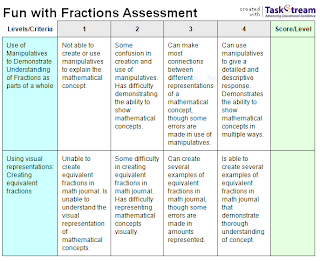For this lesson, much of the assessment was done while students were creating their fraction manipulatives. The picture above is an example of the fraction strips each students created, dividing one whole into equal-sized sections of various sizes, and labeling them. I was able to observe each student while they were working to determine if anyone needed additional help.
This sample math journal is another formative assessment that was created during the lesson. Students were compare their manipulatives to find pieces that were equivalent to each other and to write these in fraction form in their math journals. This was effective because I could observe students while they worked on their fractions and could also collect the journals afterward to compare them to the rubric and see if any students needed additional help.
I used Taskstream to create the rubric above. This helped me use the fraction strips and math journals as well as my observations of students to assess their learning. Of course all of my students got 4's on both items on the rubric, but that is because they have a little experience with fractions already and not because this was a particularly stellar lesson :)
I do think it generally went well. However, I realized after I was quite a ways into the preparation of this lesson, that it is a lesson that does not really need technology. Instead of finding a lesson that would be more effectively taught using technology, I found ways to incorporate technology into my lesson. I did not intend to do it that way, but it turned out that technology was sort of an afterthought. I think in my next lesson, I will approach choosing the content and planning the lesson with the idea of finding a more effective way of teaching it with technology in mind.



No comments:
Post a Comment